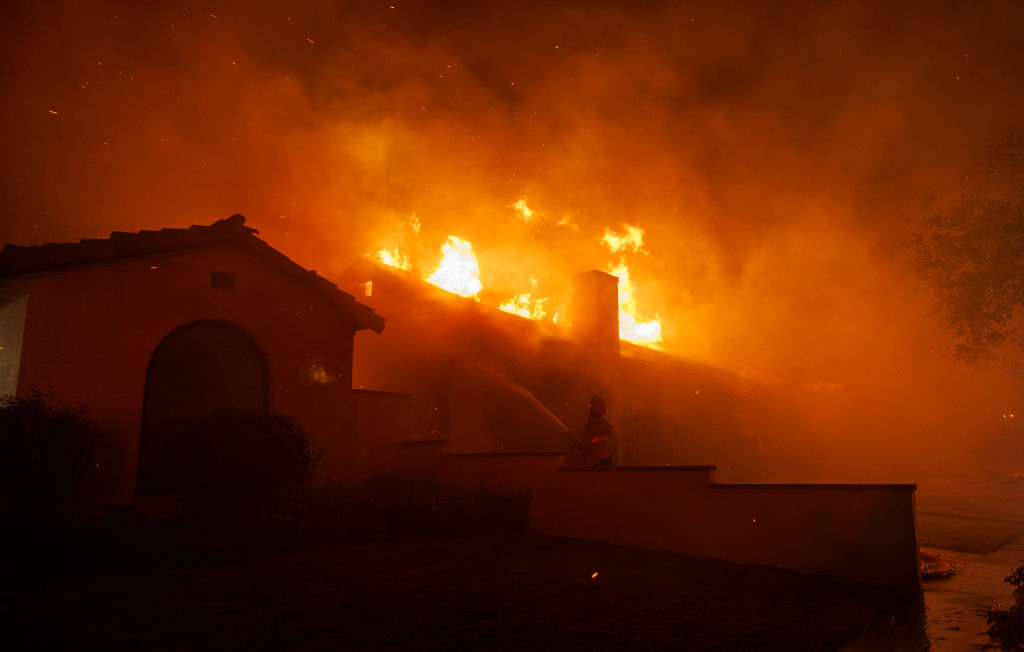Source: Gina Ferazzi / Getty
Altadena and Pasadena, two neighboring communities rich in Black culture and history, are now facing an uncertain future as the devastation from the Eaton fire threatens to erase much of their legacy. Altadena, located just 13 miles northeast of Los Angeles, boasts a population that is 18% Black, with a significant portion (65%) of residents aged 65 and older, according to the U.S. Census Bureau. Pasadena, with a 7.7% Black population, mirrors Altadena’s demographics in terms of age. Both towns have long been home to vibrant African American communities, but residents now fear the loss of this cultural heritage as the fire’s damage spreads.
Historically, Altadena played a pivotal role during the Great Migration, serving as a sanctuary for African Americans escaping the harsh realities of the Jim Crow South in the early 20th century. Seeking refuge from systemic racism and searching for better opportunities, many Black families found a warm welcome in Altadena. Here, they built tight-knit communities that would become centers of artistic, cultural, and entrepreneurial activity, nurturing Black artists, activists, and business owners who left a lasting imprint on the area’s identity.
During a Jan. 12 interview with The Associated Press (AP), Victoria Knapp, chair of the Altadena Town Council, said she worries that big developers will sweep in and buy out Black homeowners who have been displaced by the fires.
“Someone is going to buy it and develop who knows what on it. And that is going to change the character of Altadena,” Knapp worried.
Kenneth Snowden, a 57-year-old Black homeowner from the area, shared that he was among the first to purchase a home in the neighborhood in the 1960s. He purchased a second property in the early 2000s. Sadly, he lost both homes in the devastating Eaton fire, which has damaged over 6,000 buildings, according to the New York Post. Snowden is now advocating for federal and state officials to provide 0% interest home loans to help property owners recover from the destruction.
“Give us the ability to rebuild, restart our lives,” he told AP. “If you can spend billions of dollars fighting a war, you can spend a billion dollars to help us get back where we were at.”
Source: Anadolu / Getty
The history of Altadena and Pasadena.
Altadena’s origins date back to 1887 when John and Fred Woodbury, brothers from Marshalltown, Iowa, sought to create a suburban haven for the wealthy class just north of Pasadena, according to Altadena Heritage. They envisioned a retreat for millionaires, but their timing was poor. The real estate bubble burst in 1888, throwing the region into economic turmoil, a crisis that deepened during the national depression of the 1890s. Despite this, ranchers and settlers continued to develop the land throughout the late 19th and early 20th centuries, cultivating crops like grapes, oranges, walnuts, and later, dates and avocados.
Among the new arrivals were African Americans, many of whom brought with them valuable skills and the hope for a fresh start. Per Pasadena History, some of Altadena’s first Black residents, such as Joseph Holmes, who drove a cattle herd from Nebraska to Los Angeles in 1883, and the Prince brothers, William and Frank, who came from Tennessee in search of work, contributed to the area’s early development. The Princes helped establish the first Black-owned business in the area—Prince Brothers Feed and Fuel. Other Black families, like Booker and Carrie McAdoo, came in the late 1890s, seeking a healthier climate and better opportunities.
Pasadena History noted that one of Pasadena’s early civil rights pioneers, Seaborn B. Carr, moved to the area from Georgia in 1893. A dedicated member of Scott Methodist Church, he helped organize Union Day picnics to celebrate the end of slavery. Though he worked as a maintenance man due to the limited opportunities available to Black people at the time, his legacy as an advocate for civil rights remains significant.
There’s hope and a path forward.
While many African Americans moved west to escape the oppressive conditions of the Jim Crow South, they continued to face discrimination in California. Practices such as redlining, restrictive covenants, and other forms of racism severely limited where people of color could live, confining most Black residents to tightly segregated neighborhoods. In Pasadena and Altadena, these communities were often concentrated along Vernon Street (which was later removed for freeway construction), in northwest Pasadena, and in the western parts of Altadena, according to Pasadena History.
Despite these barriers, Black residents in Altadena and Pasadena thrived. They built vibrant businesses, churches, and tight-knit communities that would leave a lasting impact on the city’s cultural and social fabric. Today, the Black homeownership rate in Altadena alone stands at 81.5%, nearly double the national average, according to AP.
Shawn Brown credits the courage and fearlessness of her ancestors for making it possible for her to build a home and open a public charter school, Pasadena Rosebud Academy, in Altadena. Unfortunately, both were destroyed in the devastating Eaton fire. Now, Brown is collaborating with community members to rebuild the school.
In the wake of the disaster, Brown sent a message of hope and solidarity to fellow Black homeowners who, like her, are facing uncertainty and loss. “I would tell them to stand strong, rebuild, continue the generational progress of African Americans,” Brown told AP.
SEE ALSO:
Famous Black People Who Lost Their Homes To The Wildfires In California
Incarcerated Firefighters Endure Harsh Conditions On The Frontlines Of Los Angeles Wildfires

